What are the best things to do in Aswan? From the Nubian Museum to the High Dam, from the magnificent temples of and Abu Simbel and Philae to the romantic islands in the Nile and shopping in Aswan, here are 12 of the things to do in Aswan that made me fall in love with this Egyptian town.
Aswan is a warm, welcoming and relaxing city, full of incredible things to see and do. After the hectic time we had exploring Cairo for three days, Aswan came as a wonderful surprise – the weather was stifling hot even in March, but the traffic and street hassle were far less compared to Cairo, and we immediately felt at ease.
Egypt is an amazing country, full of history, traditions and culture – and given that Aswan is located in the south of the country, hours away from places like Cairo and Luxor, many travellers may be tempted to leave it out of their Egypt itinerary.
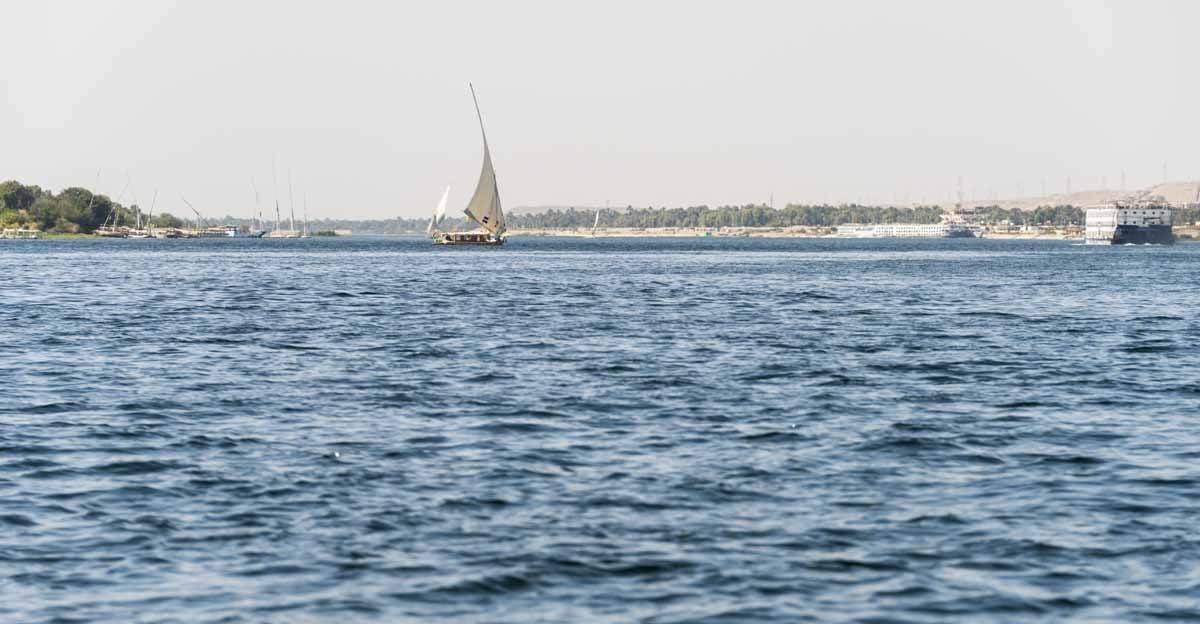
In my opinion, you can’t miss it! Not only can you learn about Ancient Egypt in Aswan, with lots of historical and archaeological sights in the city or just outside, you’ll also find peaceful Nubian villages and beautiful views of the Nile, the perfect antidote to super urbanised Cairo.
Sailing the mighty river you’ll also find some peaceful islands where you can spend a day surrounded by nature, and a few hours away you’ll find the temples of Abu Simbel and Philae, which are definitely worth mentioning among Aswan’s main things to do.
Here are our 12 favourite things to do in Aswan – do you have any more to add?
Heading to Egypt? Don’t forget to check our post about where to stay in Cairo, with all the best hotels!
1) Visit the Spice Market – Best Shopping in Aswan!

The spice market in Aswan was by far my favourite in the whole of Egypt. Every night, after spending the day touring Aswan’s many sights and attractions, we crossed the Nile by boat and spent some time browsing Sharia al-Souq, the market of Aswan, shopping for cinnamon, saffron, karkade, cloves, bergamot, pepper and nutmeg.
Located in the centre of the town, just a stone’s throw from the train station and the banks of the Nile, the Aswan spice market is the ideal place to hunt for souvenirs – its stalls are full of spices, traditional galebeyas (robes) and fabrics, silverware and treasures of all kinds.
It is a fun place to explore, and in general sellers are friendlier and less aggressive than in other markets around the country.
It’s worth shopping for perfumes, which in Aswan are said to be especially good. Nubian embroideries also make for a wonderful, unique gift, since they’re hard to find elsewhere in Egypt.
If you like karkade, the cool hibiscus drink found everywhere in Egypt, you will be spoiled for choice among the huge buckets of dark red hibiscus petals that you can buy to recreate the drink at home! Truly the best place for shopping in Aswan!

Best Places to Stay in Aswan
There are lots of hotels and guesthouses to stay in Aswan – whether you’re after a luxury, midrange or budget stay, you’re sure to find something of your liking.
If you prefer large hotels with all mod-cons, opt to stay on the Western bank of the Nile, where the centre of Aswan is located. For something more ‘local’ and relaxed, stay in the Aswan’s main Nubian village, located on the Eastern bank. All three Nubian guesthouses listed below can be found there.
Here are 6 of the best places to stay in Aswan!
- Sofitel Legend Old Cataract – colonial-style hotel on the West bank of the Nile views and wonderful gardens
- Pyramisa Isis Corniche Aswan Resort – modern hotel on the Aswan Corniche, offering great value for money, ideal for those who want to be near the city!
- Mövenpick Resort Aswan – unique location on Elephantine island, surrounded by nature, silence and lots of historic sites nearby
- Anakato – guesthouses in colourful Nubian houses, with three locations in the Nubian village in Aswan
- Nubian Holiday House – in a secluded location in the Nubian village in Aswan, this guesthouse run by friendly Habibi has a spectacular rooftop with Nile views
- Ekadolli Nubian Guesthouse – another solid guesthouse option in the Nubian village near Aswan
2) Learn about Nubian History and Culture at the Nubian Museum
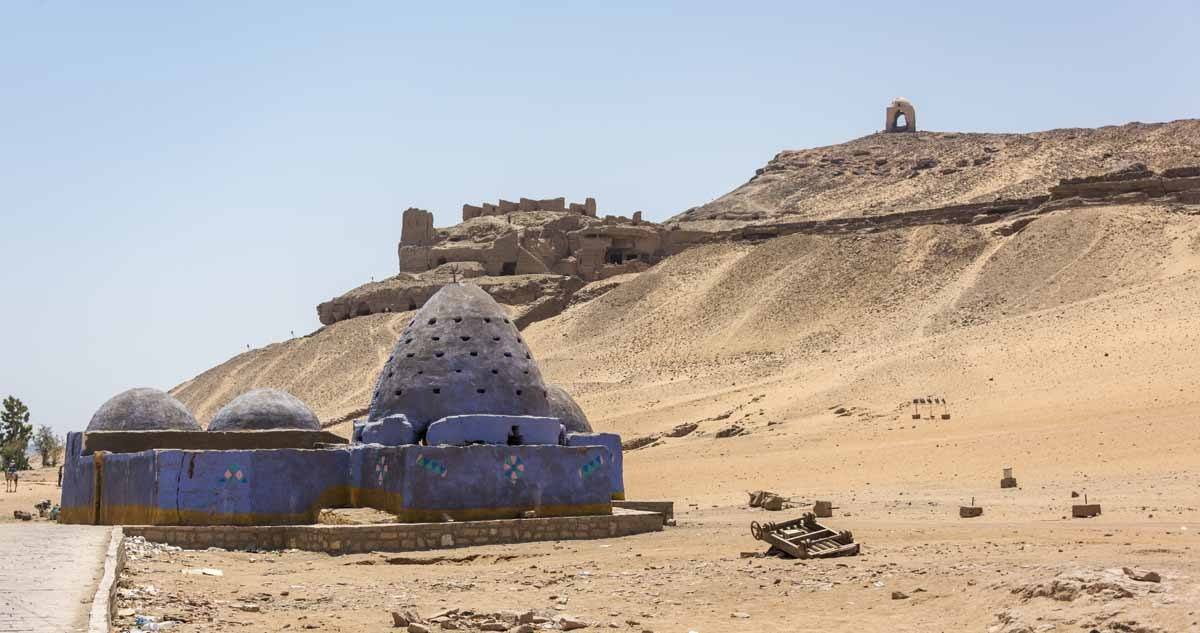
After spending an entire afternoon exploring the magical Egyptian Museum in Cairo, we couldn’t miss the Nubian Museum, the best thing to do in Aswan according to Lonely Planet!
If you are interested in the culture and history of the Kingdom of Kush (ancient Nubia) this museum is a must. It documents and showcases a culture that has been more or less wiped out with the construction of the Aswan Dam, which flooded much of the original valley.
On display there are also many wonderful black and white photos of the incredible project put in place to save the Philae and Abu Simbel temples from the rising waters of the dam, along with extensive photographs of other monuments that are now lost forever under the waters of the lake.
In addition to fully explaining the history of Nubia and its people, the ethnographic section shows beautiful Nubian handicrafts and folk art.
Do not miss the mud brick mausoleums of the Fatimid cemetery, just behind the museum. The cemetery keepers are happy to take visitors on a tour and can show you the most interesting mausoleums, but do not forget to leave them a small tip (they will definitely remind you!)
3) Escape the Traffic at Elephantine Island

Aswan may be chilled out in Egyptian terms, but it is still a busy city. If you want to escape some of the bustle but still explore some Ancient Egypt in Aswan, your best bet is heading to Elephantine Island, the largest island in the Nile just opposite the city of Aswan.
Part of the island houses the Mövenpick Resort Aswan, one of the top luxury hotels in the city, and a solid accommodation choice if you’re after a hassle-free stay. The island is a delightful place for a walk, wandering the quiet, dusty streets of the traditional Nubian villages of Koti and Siou, with their brightly-painted houses.
Koti and Siou are inhabited by the descendants of the ancient population that inhabits the region comprised between Southern Egypt and Northern Sudan. Nubian villages are known for their bright wall paintings – you’ll also notice that life happens in the street, with children running around and playing, and groups of locals chatting on their doorsteps and courtyard.
The Nubian villages of Elephantine Island are a street photographer dream, but please don’t forget to be respectful and don’t ‘other’ or exoticise locals in your photography, and don’t take shots without their permission. Ask them kindly, and spend some time getting to know them before snapping away.
4) See the Nilometer and Aswan Museum
At the southern tip of Elephantine Island you’ll also find the ruins of Abu, the oldest settlement in Aswan, including the ancient Temple of the Kingdom of Khnum and the Temple of Satet.
Nearby there is also the Aswan Museum – however, the main section, housed in the villa of Sir William Willcocks, is currently closed for restoration. You can only visit the modern annex, but the artefacts it contains are very similar to those found in the Nubian Museum.
Down a flight of stairs on the southern tip of the island you’ll also find the famous nilometer, one of the most famous things to see in Aswan, and an example the engineering skills and sophistication of ancient Egyptians.
The ancient Egyptians used the nilometer to measure the river level, the times when the water lowered and when it rose, allowing them to estimate the height of the yearly floods, and then to predict the success of the harvest.
Elephantine Island is an interesting place to get to know local life, and it will only cost you 2 LE (Egyptian pounds) to reach it by boat from the Aswan pier. Some boatmen will try to charge you more claiming that 2 LE is ‘Nubian price’, but please stand firm and refuse to pay any more.
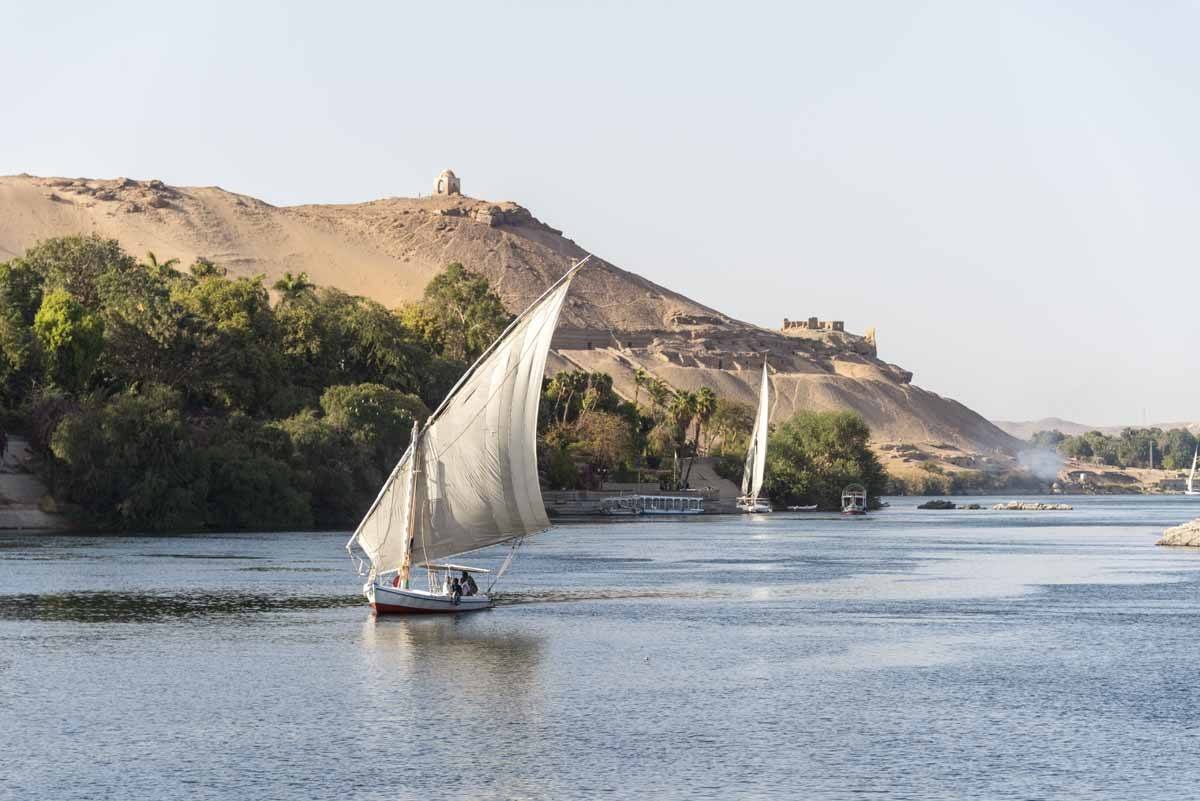
4) Have a Drink at the Old Cataract Hotel
Confession time – I LOVE historic hotels, the kind of place where you can retreat to for a drink or to sit in a shaded garden, following the footsteps of legendary travellers.
One of such places is the Old Cataract Hotel, a former British colonial property now managed by Sofitel. After being closed for a lengthy restoration, the hotel is now back in business – inside you’ll find crimson chandeliers, Moorish domes, Persian carpets, and a timeless decadent feel throughout.
The walls of the lobby are adorned with the photos of former guests like Lady Diana, Winston Churchill and Agatha Christie, who also used the hotel as a setting for her novel Death on the Nile.
Rooms with Nile view can be had for about €250, which is a steal considering that the hotel is absolutely stunning. Otherwise, you can still experience the atmosphere visiting the panoramic terrace with views over the Nile and Elephantine for a cup of tea or karkade.
5) Go Wow at the Aswan High Dam
Another unmissable thing to do in Aswan is driving to the High Dam, both for the views and for the opportunity to learn about this engineering marvel.
The High Dam and artificial lake Nasser, the consequence of its creation, were a very controversial project, built between 1960 and 1970 and still very much discussed today.
On one hand, the dam supplies electricity to the whole of Egypt – but on the other, its creation came at a huge cost. Many Nubian villages were submerged, displacing inhabitants and forcing them to city life, and forcing temples and archaeological sites to be relocated.
Abu Simbel is just one of many – another temple that had to be moved is the Temple of Dendur, now located on the ground floor of the Metropolitan Museum in New York.
From an environmental point of view, the dam stopped the annual Nile flood. This increased the amount of arable land, but also introduced the need for fertilisers, an extra expense for many local farmers. Before the construction of the dam, fields were fertilised by silt deposits brought by the river through the floods.
The construction of the dam was financed by funding and technical assistance from the Soviet Union during the Cold War, when Nasser was trying to defend Arab nationalism in opposition to the American influence in the region. There is still a Soviet-Egyptian friendship monument that can be seen.
Here are some statistics related to the Aswan High Dam, to give you an idea of the sheer size of the project. Its construction required 42.7 billion cubic meters of stone (17 times the volume of the Pyramid of Cheops), and it has total length of 3.6 kilometers.
It has a thickness of 980 meters at the base and 40 meters at the highest point, and the average capacity of the dam reservoir (Lake Nasser) is 135 billion cubic meters, with a maximum capacity of 157 billion cubic meters.
A four-lane highway crosses the top of the dam, where you can see a triumphal arch and the friendship monument.
Tours of the Aswan Dam are often included on day trips, or you can easily hire a taxi from Aswan to get there.
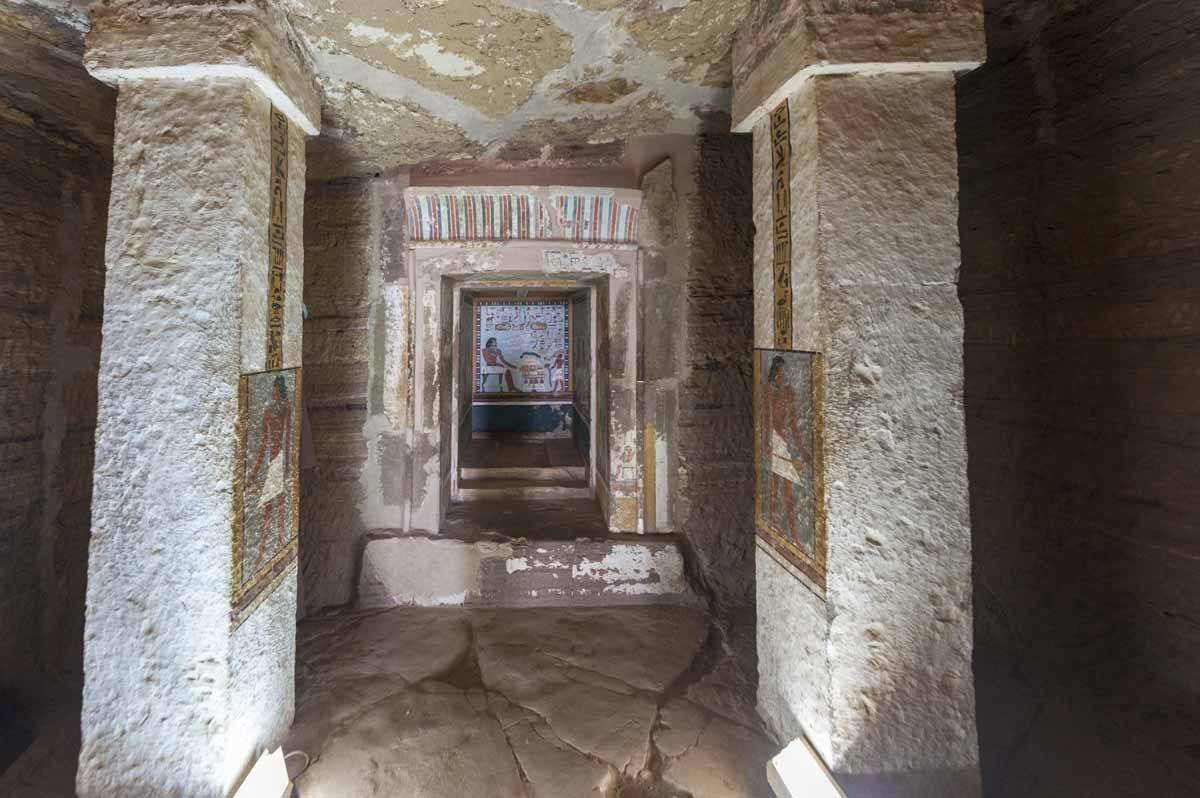
6) Go Wow Again at the Unfinished Obelisk
During the times of ancient Egypt, many temples and monuments were built with granite coming from the quarries in the vicinity of Aswan, said to be the best in the country.
The Northern Quarry near Aswan still houses what was going to be the world’s tallest obelisk – the Unfinished Obelisk, a mammoth slab of granite 42 meters high, 10 more than the Lateran Obelisk in Rome, the tallest standing one in existence.
Not much is known about the Unfinished Obelisk – who commissioned it, where it was going to be placed and when. It is assumed that its construction was abandoned due to large cracks in the rock that rendered it unstable.
It’s definitely one of the most interesting things to do in Aswan, and a great place to learn about Ancient Egypt in Aswan – you can still see original worker’s marks, providing an insight into the construction techniques of the time of the Pharaohs.
Here’s a great tour including the Obelisk!
7) Wander the Botanical Gardens in Kitchener Island
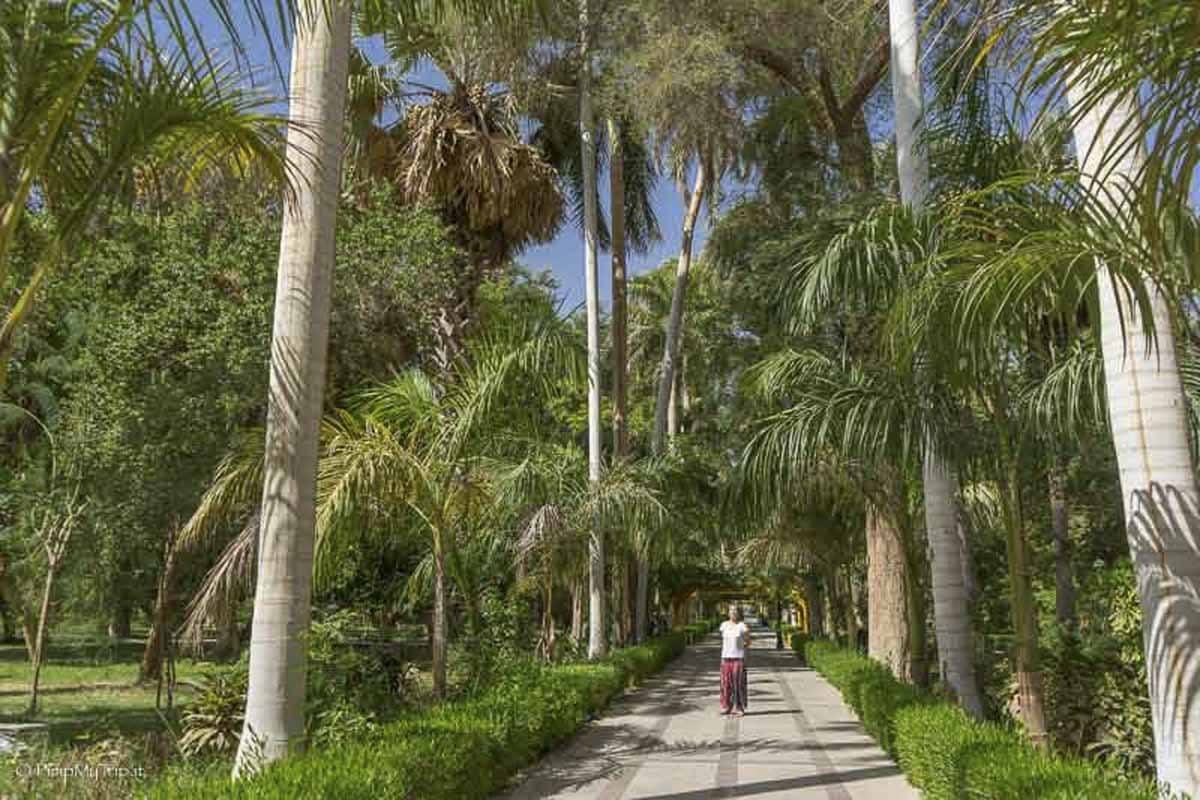
If you love nature, one of the most unforgettable things to do in Aswan is exploring El Nabatat Island, also known as Kitchener Island, located right next to Elephantine Island on the Nile.
This island was once owned by Lord Kitchener who turned it into a verdant garden of exotic plants from Asia and Africa – after his death, the island passed into the hands of the Egyptian government, who was used as a research station and turned it into a botanical garden.
The island’s gardens house many species of palms and other native flora – including rare palm trees such as the Royal Palm, Sabal Palm, and the Phonic Pam tree. The island is very popular with the locals for picnics or just for afternoon walks, and it can easily be reached by motorboat or felucca from the Aswan Pier.
8) Experience Local Life in the Nubian Villages near Aswan
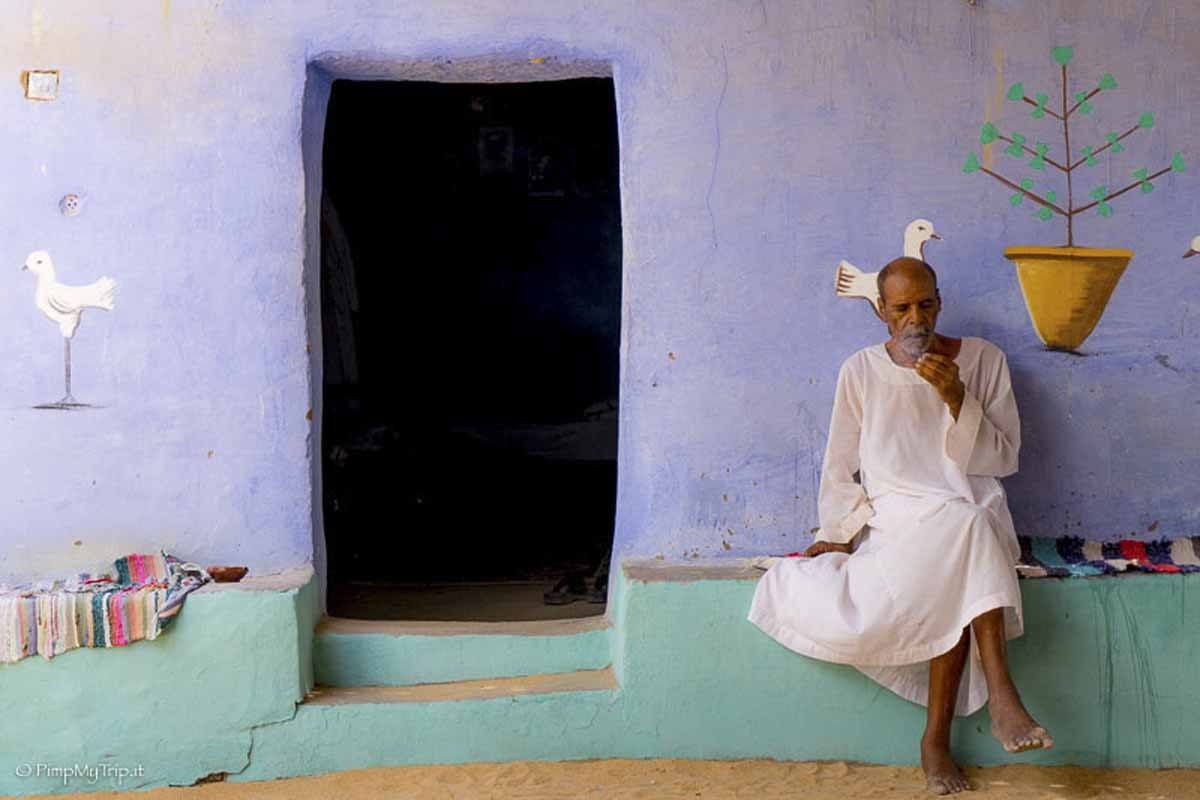
As we mentioned before, Nubian people are indigenous of Southern Egypt and traditionally they live in houses painted in bright, vivid colours. The floors are made of sand, and not all rooms have a roof, because it rarely rains in Aswan.
You can see some traditional Nubian villages in Aswan – there are some on Elephantine Island, or just make your way across to the Eastern bank of the Nile, where you’ll find more Nubian villages, including some guesthouses.
Historically, the Nubians lived in the Nile valley south of Aswan. However, the flooding caused by the construction of the High Dam submerged many villages, forcing people to move closer to the city.
South of Aswan, there’s a pretty Nubian village that is often visited during felucca excursions, but the atmosphere is somewhat manufactured. We recommend staying at the Nubian Holiday House just across the Nile, and explore the surrounds and the villages on Elephantine independently.
Two words of warning about visiting Nubian villages in Aswan. Please avoid giving sweets or tips to children in exchange for photos, and only take pictures if you can ask an adult for permission. Also, some families keep crocodiles in their houses to show tourists – these crocodiles are usually kept in dire conditions, so don’t reinforce this practice by taking pictures or paying to see them.
9) Enjoy the View at the Tombs of the Nobles

The Tombs of the Nobles, located on the Eastern bank of the Nile not far from the Nubian village, are mainly tombs of Egyptian princes dating back to the Old Kingdom, but there are some that belong to the Middle and the New Kingdom.
Inside, the tombs have marvellous paintings showing scenes of everyday life, but many of the tombs are closed due to maintenance work. However, you might find some ‘guardians’ offering to open them up for you – for a fee, of course!
The most recognisable tomb is Qubbet el-Hawa, also known as ‘the wind dome’, located on the top of the sand hill. Inside, there is nothing to see, but the hike to the top is worthwhile, with excellent views of the entire Nile valley, as well as Aswan and the nearby Nubian villages.
The hike is very sandy it’s very hot year round, but in summer the heat becomes truly unbearable. Try to go there early in the morning, or towards sunset!
10) Check Out the Aga Khan Mausoleum
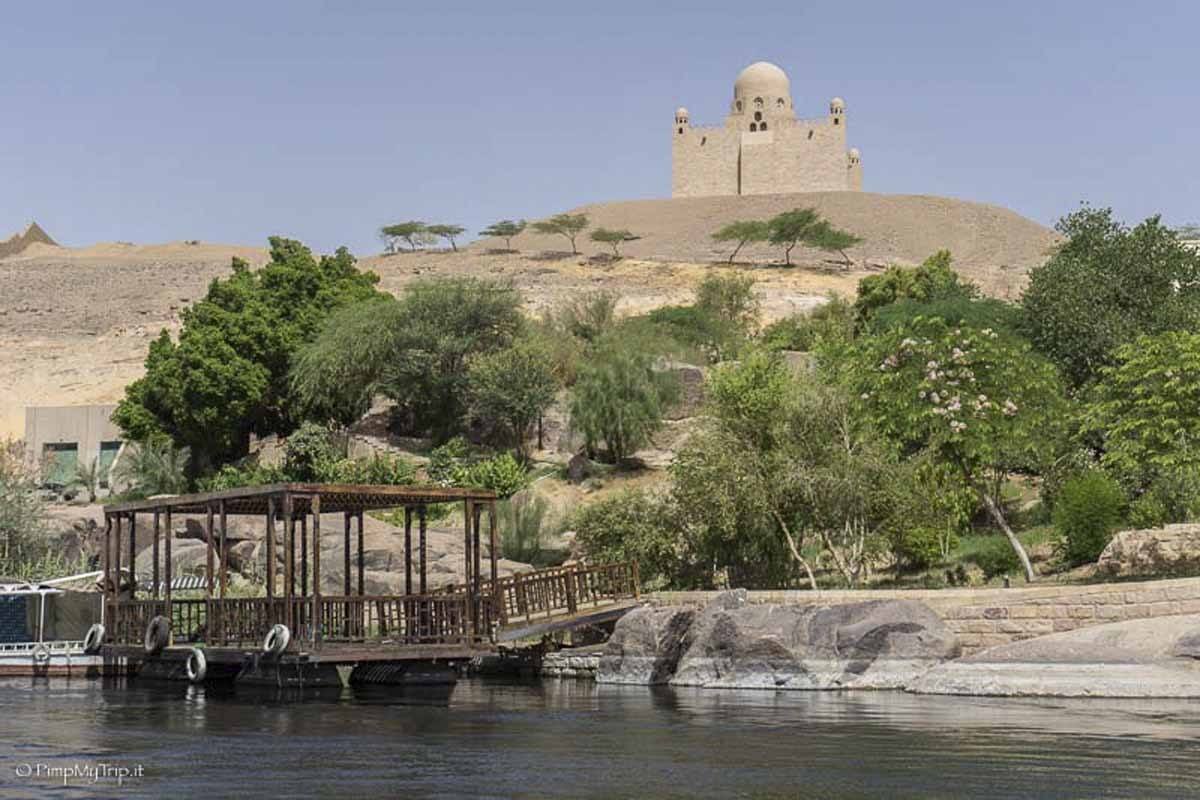
This is definitely one of the most off the beaten track things to do in Aswan. The Aga Khan Mausoleum stands out imposingly and austere on the top of a hill overlooking the Nile, close to the villa where the Aga Khan used to spend part of the winter all throughout his life.
The Aga Khan was the 48th Imam of the Shiite Ismaili Muslims, a sect that was mostly developed in India. He died in 1957 and a pink limestone mausoleum was built not far from his villa, in the style of Fatimid tombs.
After the Aga Khan’s death, his surviving widow continued to leave a red rose on his white marble tomb in Carrara. The custom continues, and every day a red rose is still placed on the sarcophagus.
11) Visit Philae Temple

Another not to be missed thing to do in Aswan, Philae Temple is located on an island in the middle of the Nile, so you’ll have to hire a boatman in Aswan to take you or join a tour.
Yet, that’s why this temple is so special – reaching it requires a bit of planning (or fierce negotiating with felucca captains), and few people make the effort. You might even have the place to yourself, if you visit later in the day.
Dedicated to the deity Isis, the main temple was transferred by UNESCO to the neighbouring island of Agilkia, after the site was partly flooded by the construction of the Aswan dam.
The ruins of a Christian church have been found within the temple grounds. It is believed that these early Christians are responsible for the damage inflicted on the hieroglyphics on the left side of the temple – Christians believed that the left side, that of the heart, should be pure and not contain non-Christian imagery.
It takes about an hour to explore the Temple, marvelling at the intricate hieroglyphs and carvings. Entrance costs 100 LE, and the journey by felucca costs 120 LE return (not one way, as some boatmen will claim!)
Check out some of the best tours including Philae Temple
12) Don’t Miss Abu Simbel
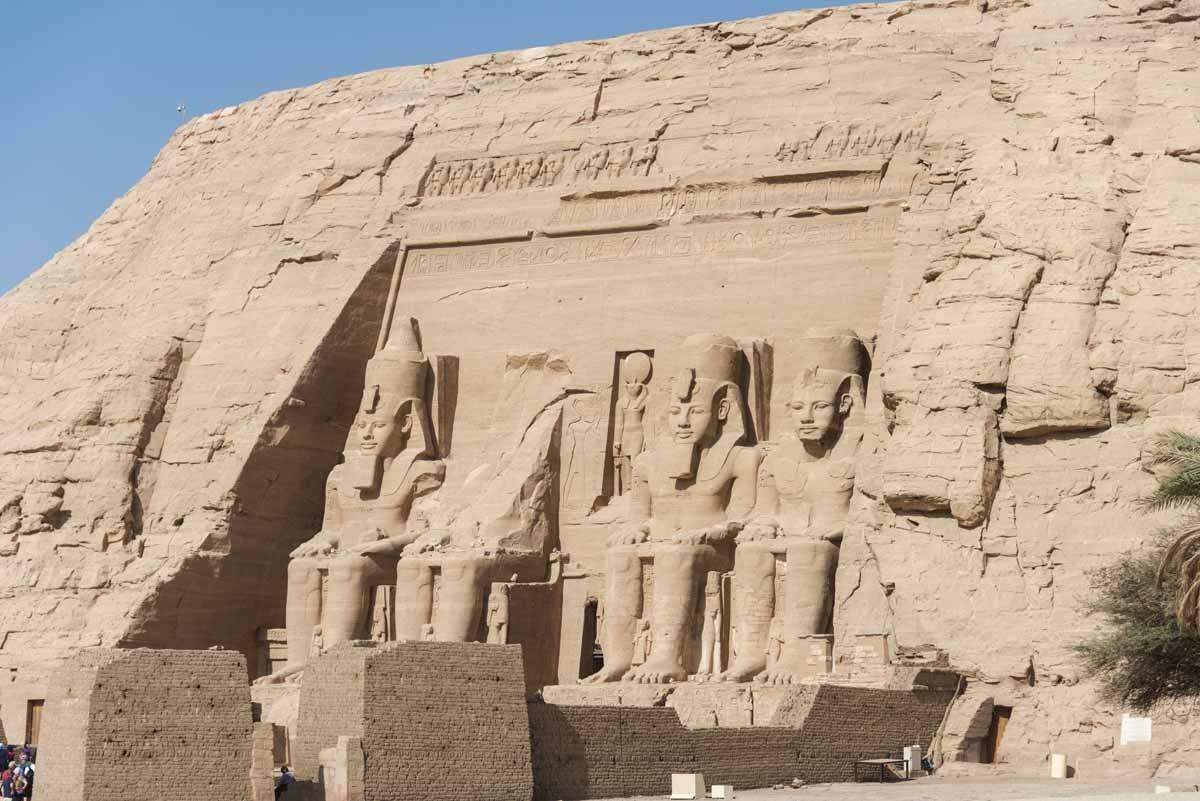
Let’s save the best for last, shall we? To be honest, visiting the magnificent Temples of Abu Simbel was right at the top of my list of things to do in Aswan!
Built by Ramses II, the temples of Abu Simbel are located about 280 km from Aswan, but they are easily accessible with tours that you can book online, in all travel agencies around Aswan or through your hotel or guesthouse.
Tours start around 4 am to beat the fierce heat – driving time is about three hours and you’ll usually have plenty of time to enjoy the archaeological site with no need to rush. There are two temples at Abu Simbel – the Great Temple, dedicated to Pharaoh Ramses II, and the smaller one, for his wife Nefertari.
Both temples have monumental entrances with colossal statues, and exquisite hieroglyphs and wall paintings all inside. The temples sit on the shores of Lake Nasser – they were moved from their original location before the High Dam was built. Don’t miss the chance to learn more about it by taking a guided tour – it was definitely our favourite thing to do in Aswan!
Here are some of the best Abu Simbel tours
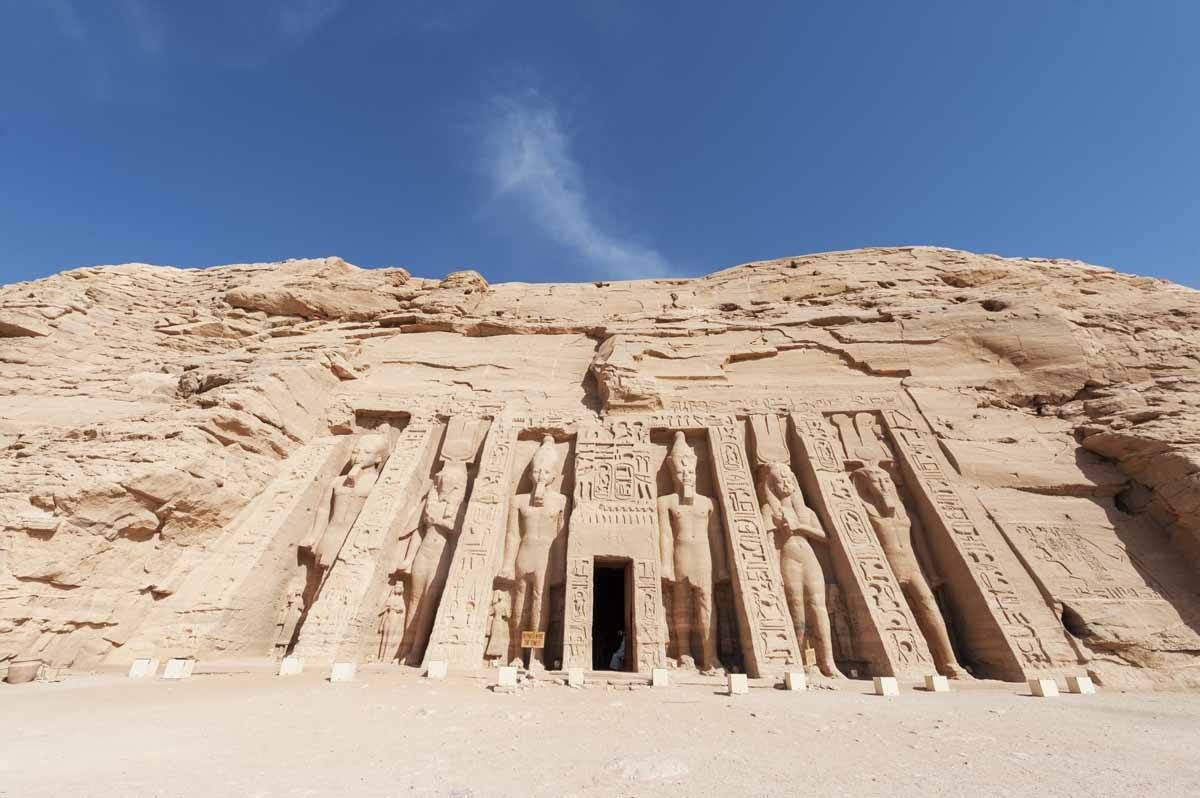
How to Get to Aswan
- By Plane – you can easily reach Aswan by plane from Cairo, with Nile Air or Egyptair. Flight time is 90 minutes and flights cost about €120 one way.
- By Train – if you’re travelling to various locations around Egypt, the train is a comfortable and convenient way to move around. You can take an overnight train between Cairo and Aswan (travel time is about 13/14 hours) and it’s about 6 hours from Luxor to Aswan and vice versa.
- By Bus – there are buses travelling between Cairo and Aswan, but the train is a much better option.
- By Boat – naturally, the most scenic way to reach Aswan is by boat! All Nile cruises stop in Aswan. Aswan-Luxor takes 3 nights, and Luxor-Aswan takes 4 nights. You can book your Nile cruise in advance for the best rates, or can pick one up in either Luxor or Aswan for about €75/150 per day, but departures are not every day.
- By Felucca – if you love adventure, you may also opt to depart Aswan by felucca. A three-day felucca cruise to Kom Ombo costs about €60 a day including meals. However, be prepared to rough it!
